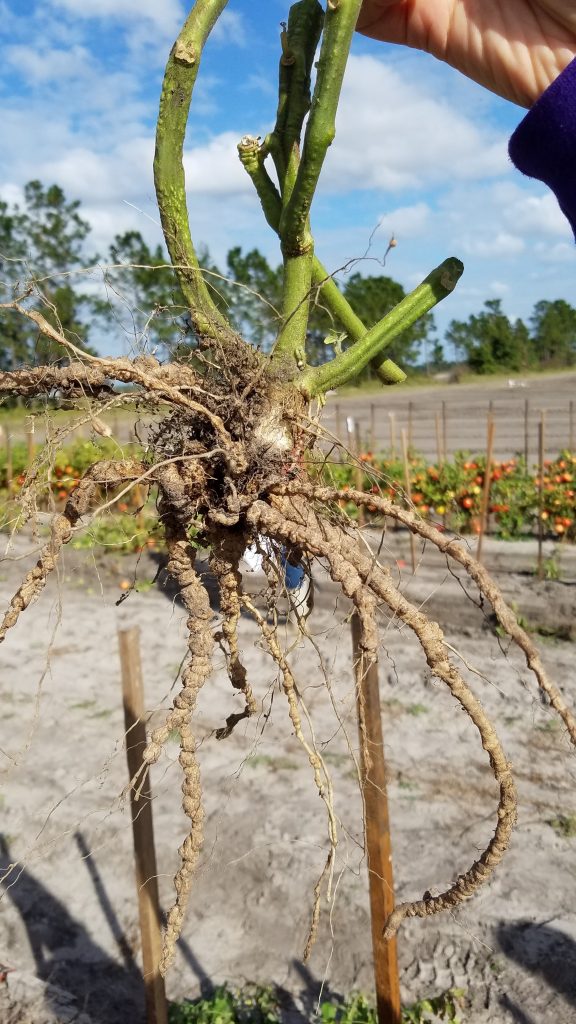
By Johan Desaeger
Root-knot nematodes (Meloidogyne spp.) are one of the most rapidly spreading of all pests and pathogens. The southeastern United States (Florida, in particular) is a paradise for these parasites. Nematodes cause damage to vegetables all over the world, and anyone who has had to deal with root-knot nematodes knows how difficult they are to control.
Root-knot nematode damage is often not recognized and is frequently confused with other biotic or abiotic problems, such as disease, nutritional and watering issues. When nematode populations are high and weather and soil conditions are favorable, root-knot nematode damage can become so bad that total crop loss occurs. This is especially the case when soils are already warm at planting or when a double crop is planted on the same bed.
Soil fumigants like Telone-chloropicrin mixtures and metam-based products like K-Pam are the most effective products when nematode pressure is high. Deep-shank (18-inch) injections of Telone can provide additional control in problematic fields by targeting nematodes that hide in the subsoil. Fumigants must be applied at least three weeks before planting to avoid phytotoxicity to the crop.
NEW NEMATICIDES
In the past, when beds were not fumigated, nematicide options for vegetable growers were limited to Vydate (oxamyl) and a few biological products. Over the past years, two new nematicides, Nimitz and Velum, have become available for vegetable growers in the Southeast. The new nematicides are less toxic and have a safer label (caution instead of danger) than previous products. They can easily be applied through drip irrigation systems. These nematicides should not be considered fumigant replacements, as they will target only nematodes. Additional measures need to be taken to manage soil diseases and weeds.
Nimitz should be applied seven days before planting to reduce the risk of phytotoxicity to the crop, while Velum can be applied before and after planting. Fluopyram, the active ingredient in Velum, is the same as in the fungicide Luna, although no clear evidence of soil disease control was observed for Velum in University of Florida Institute of Food and Agricultural Sciences (UF/IFAS) experiments. Care should be taken not to exceed the maximum annual use rate of fluopyram when using both Luna and Velum.
Both Nimitz and Velum have been extensively tested at the UF/IFAS Gulf Coast Research and Education (GCREC) farm and are currently being evaluated in commercial fields. Their performance against root-knot nematodes on a variety of vegetables such as tomato, cucumber, squash, cantaloupe and watermelon was generally good and comparable to Vydate. Unless nematode pressure is too high, these products are a good alternative for growers that cannot or do not fumigate, or they may provide additional nematode control after fumigation when nematode pressure is high or long-season control is required.
ORGANIC OPTIONS
For organic growers, several biological products are available. They can be toxins derived from plants, bacteria or fungi while others are biocontrol organisms such as several species of bacteria and fungi. Some product names are ProMax, Kyte Gold, Ecozin, Dazitol, Majestene, DiTera and MeloCon. Typically, organic nematicides require multiple applications. In conventional production, they can be used as part of a program with chemical nematicides. Research into organic nematicides’ potential is ongoing at the GCREC and will be reported in future updates.

Cover crops can also be good options to include in a nematode management plan. Summer cover crops like sunn hemp and sorghum-sudan grass can help reduce populations of most species of root-knot nematodes. The most common species in the Southeast are the southern (M. incognita), Javanese (M. javanica) and peanut (M. arenaria) root-knot nematodes. Often, vegetable fields will harbor more than one of these species. However, many more species exist.
In Florida, more than 15 root-knot nematode species have been found, including seven in vegetables. One particularly virulent and aggressive species is the guava root-knot nematode (M. enterolobii). This nematode has become a serious concern for the sweet potato industry in the Southeast and can cause severe damage to almost all vegetables grown in the region.
RESISTANT CULTIVARS
Vegetable growers that fumigate may not care much what species of root-knot nematode they have in their field as fumigants probably kill all species equally. However, knowing your root-knot species does matter when cover crops or nematode-resistant tomatoes are part of the nematode management plan. Research at the GCREC has shown that while some cover crops, like cowpeas, may be poor hosts to certain species of root-knot nematodes, they may be good hosts to other species.
Also, when root-knot nematode-resistant tomato cultivars are used, it is important to realize that while these cultivars are resistant to the three most common species mentioned above, they are not resistant to other root-knot species (including guava root-knot). Nematode-resistant tomato cultivars performed very well in root-knot nematode infested fields in recent trials in Florida. Root gall damage was negligible, and yields were increased compared to a susceptible cultivar. Fears, based on earlier reports that the nematode resistance gene in these cultivars might break down in the warm soils of Florida, were unjustified in GCREC trials.
The resistant cultivars also greatly reduced nematode reproduction and root-knot soil numbers by the end of the crop. This is often not the case when only a fumigant is used, as the fumigant will protect the crop from early nematode damage and yield loss, but nematode populations often increase by the end of the crop. Nematode-resistant cultivars are the easiest and cheapest method to manage root-knot nematodes, but unfortunately nematode resistance is rarely a priority in tomato and vegetable breeding programs.









